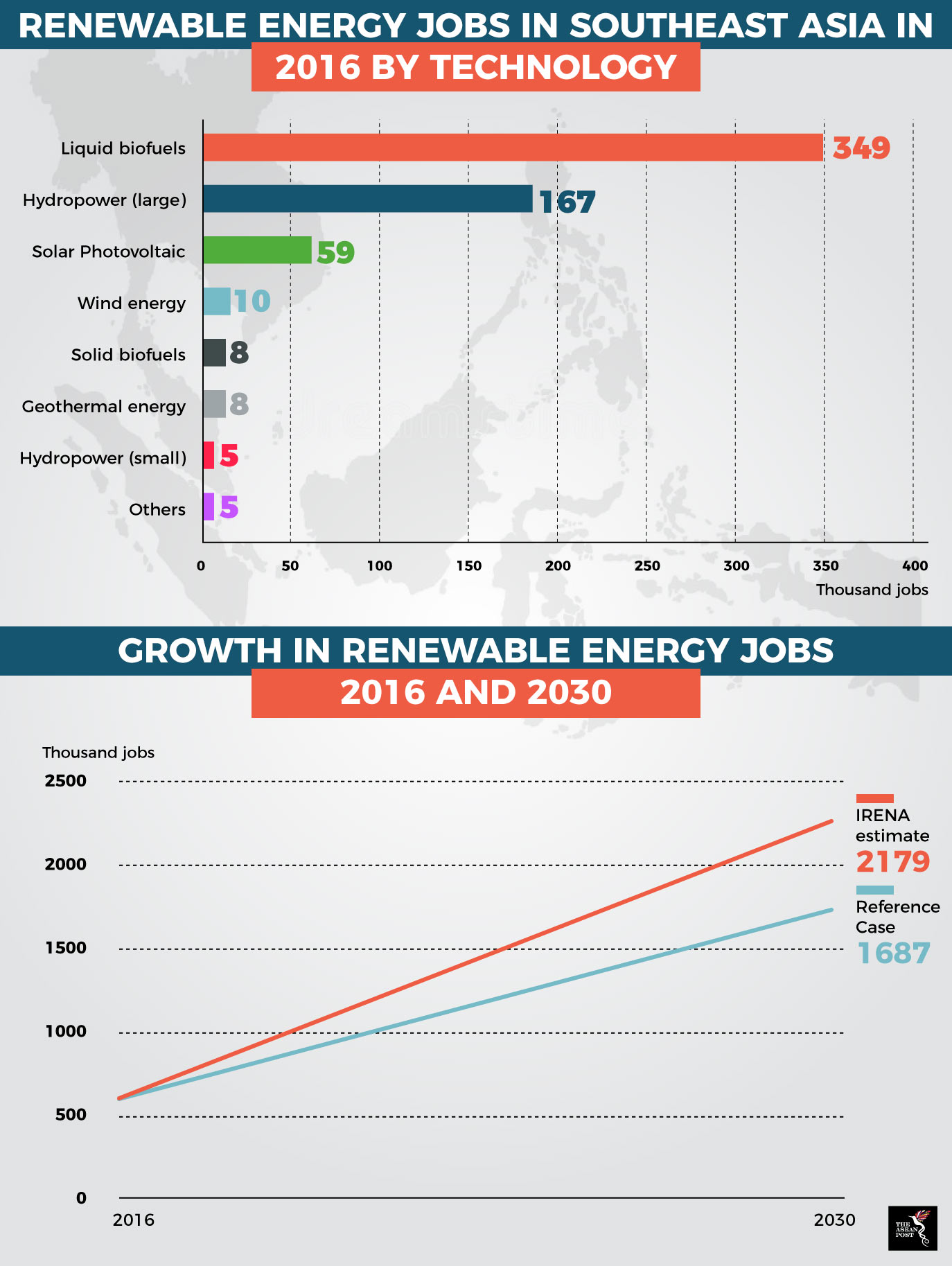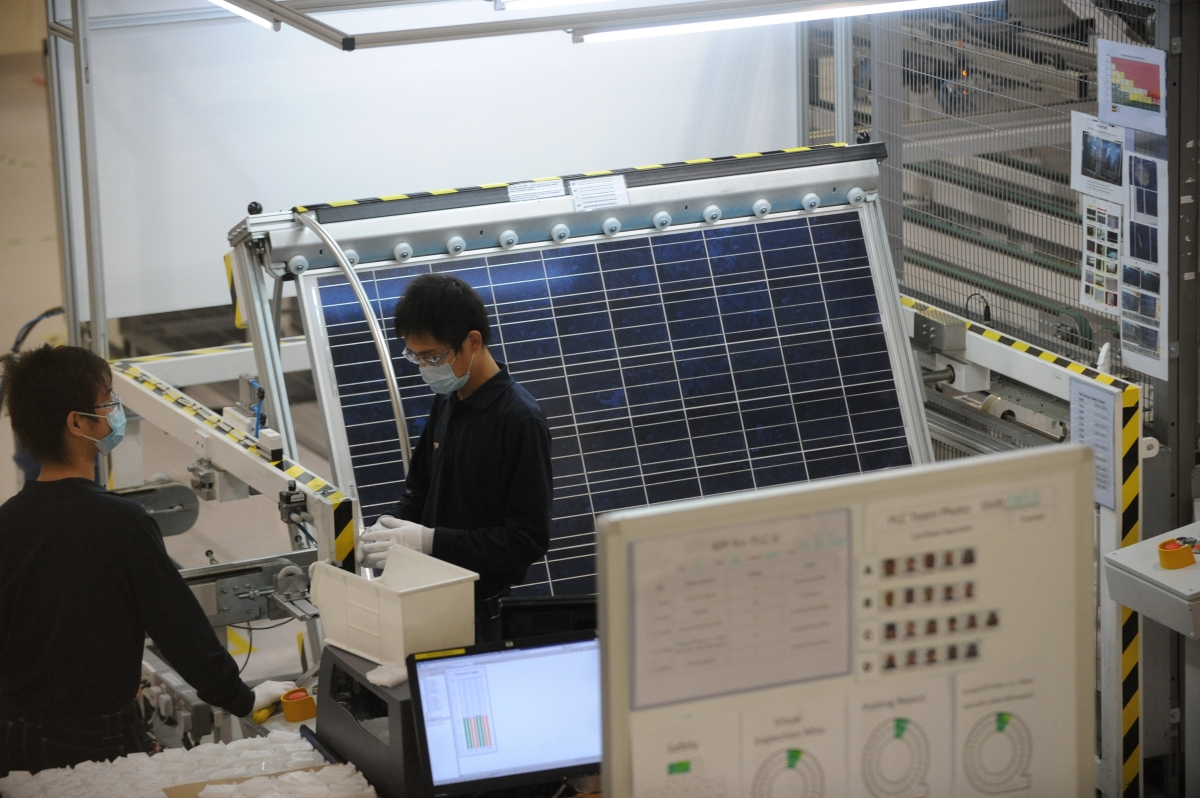Job creation has always been an important priority for governments in the region, and with an estimated 68 million new workers entering ASEAN’s labour force by 2025, it will remain a priority in the coming years. One segment which is likely to see the generation of new potential job opportunities is renewable energy.
According to estimates by the International Renewable Energy Agency (IRENA), as of 2016, renewable energy accounted for 611,000 jobs in Southeast Asia. A majority of the jobs were credited to liquid biofuel production, followed by large hydropower and solar photovoltaics (PV). Combined, these three renewable energy sources account for about 94 percent of all renewable energy employment in the region.
These three technologies are slated to grow even further going into the future. Projections by IRENA indicate that by 2030, employment opportunities created by renewable energy technologies will almost triple, from 611,000 to between 1.7 million to 2.2 million jobs.

Driving biofuel forward
Four countries, namely Malaysia, Indonesia, the Philippines and Thailand, are leading the biofuel charge in Southeast Asia, with liquid biofuels generating the highest number of jobs related to renewable energy.
Liquid biofuels alone accounted for more than half of the total number of those employed in the renewable energy sector, at 349,000 jobs in 2016. Indonesia accounted for 154,300 jobs – almost half the total number of jobs. Thailand, Malaysia and the Philippines reached 28 percent, 15 percent and 12 percent of total liquid biofuel employment in Southeast Asia, respectively.
Solid biofuels on the other hand, only accounted for 8,000 jobs in the region as of 2016. However, jobs in both, solid and liquid biofuels are expected to more than triple to about 1.4 million jobs by 2030. Driven by increasing investments in the larger biofuel sector, bioenergy will continue being the largest renewable energy employer in the region, accounting for 62 percent of all renewable energy jobs in 2030.
Leading the hydropower wave
The most dominant source of renewable electricity in the region is large hydropower, the production of which accounts for 167,000 jobs. These opportunities mostly involve operation, construction, installation, maintenance and manufacturing in large hydropower stations.
Vietnam is the largest employer in the large hydropower business with approximately 100,000 jobs, followed by Indonesia with 45,000 jobs and finally Myanmar with 13,100 jobs. Other Southeast Asian nations contribute a combined total of 8,900 jobs.
On the other hand, the contribution of small hydropower to job creation is almost negligible, at only 5,000 jobs created across the region.
The job outlook for the hydropower industry – both small and large – is rosy. IRENA predicts an uptick in employment opportunities from 172,000 to 276,000 jobs by 2030. However, given increased hydropower investments in Lao PDR and Malaysia, as well as Myanmar’s foray into small hydro installations to bridge the urban-rural electrification gap, that number could very well increase. Under a best-case scenario, hydropower jobs could more than double to 387,000 jobs by 2030.
Spotlight on solar power
The burgeoning solar PV industry in the region is also seeing an increase in jobs, especially in the manufacture of solar PV modules. Employment in the solar energy segment stood at 59,000 jobs as of 2016. The largest employers in the region are Malaysia and the Philippines, each with approximately 25,000 jobs.
Strong investments in the solar energy segment throughout the region will see employment soaring sixfold to 333,000 jobs by 2030. A key driver for this increase is the manufacturing of solar components, which requires a broad range of technical, marketing, administrative and engineering skills.
The development of such skills, which would make the overall solar energy value chain more efficient, will be crucial to the deployment of solar technology as a renewable energy source in the region. Besides that, the segment also has the potential to create jobs in related industries, including real estate, financial planning and taxation.
Overall, Indonesia and Malaysia look to be the leaders in renewable energy employment going into the future. However, as more and more nations jump onto the renewables bandwagon in the region, stiffer competition can be expected in this space from the likes of Thailand and the Philippines. Nevertheless, it is safe to say that the job market for renewable energy in the region is looking favourable, which spells good news for those seeking employment in this sector.
